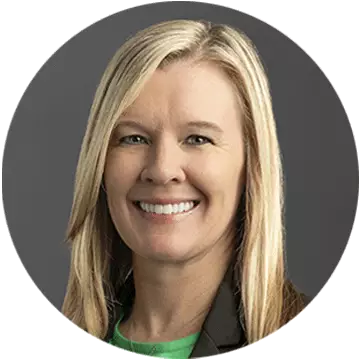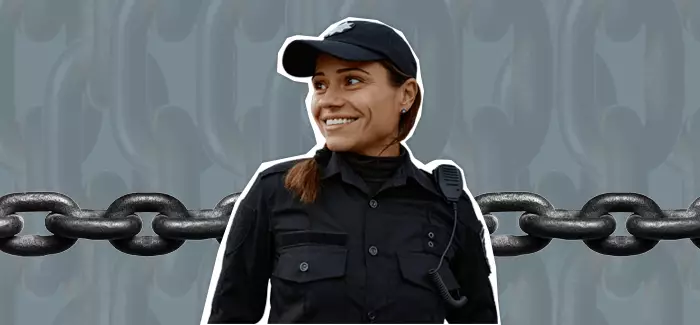Articles > Criminal Justice > What is a security officer vs. security guard?
What is a security officer vs. security guard?

Written by Camilla Andersson

Reviewed by Christina Neider, EdD, Dean of the College of Social and Behavioral Sciences

Are you wondering what the difference is between a security officer vs. security guard? While some may use these titles interchangeably, the roles have different responsibilities and requirements. We break down the differences here!
Job responsibilities for a security officer vs. security guard
If you’re looking into security jobs, start by learning the differences between a security officer vs. security guard.
Security staff keep assets and facilities safe from potential security threats, such as burglaries, theft, vandalism and trespassing. The main difference between a security officer vs. security guard is that, generally, the former is a higher-level position with more authority, and the latter is an entry-level job.
General security staff’s primary responsibilities are to detect, deter, observe and report potential theft or transgressions. However, the duties depend on their level within the security company. Let’s break down detect, deter, observe and report a little more:
- Detect: To notice potential security risks.
- Deter: To discourage criminals by being present.
- Observe: To keep an eye on a location, facility or event, whether in person or via security cameras.
- Report: To call for backup or law enforcement when appropriate.
Security staff may also respond to alarms and write reports. They may stay primarily in one location (sometimes called a “fixed post”) or be on mobile patrol (for example, by car) or foot patrol.
They might focus more on preventing crimes, which is called proactive security. Others respond to crimes, such as dispatching to an alarm, which is called reactive security. Some guards do both proactive and reactive security.
Guards often report to an officer or a more senior position. Officers have similar responsibilities, but they might also manage security procedures and staff. They may create safety protocols and other plans to deter crime. They are also responsible for training security staff.
Officers might plan and implement training drills, such as active shooter drills, and develop strategies for how to deal with other emergencies. They may also be in touch with law enforcement as needed. They might, for example, connect and share information on a regular basis with the community liaison or crime prevention department of the local police station.
Guards might also screen people, check their bags, grant access to an event or facility, or escort them from point A to point B.
Because the two jobs share some overlap, the terms are sometimes used interchangeably. The exact difference between a security officer vs. security guard can also vary among states, depending on local licensing requirements for the different titles.
In California, for example, you need a guard card if you work for a security company and a Proprietary Private Security Officer (PSO) license if you work for a bar, restaurant or other venue that serves alcohol.
In some states, security staff licenses are divided into different levels based on the training, experience and permit to carry a weapon. To be clear, though, security staff are not part of law enforcement, but they may collaborate with local police departments.
Potential security staff should learn what license or credentials they need in their state because, in some states, they can be liable if they work without one. Looking at the differences between security officer vs. security guard can help you determine which path you want to start working toward.
Qualifications and training for security officers and guards
Another difference between job requirements for a security officer vs. security guard is that officer jobs typically require more training or experience.
Qualifications for officers vary depending on the workplace. It may help to have experience in security or a relevant field, such as law enforcement or corrections. Security staff typically have a high school diploma and relevant security training. Some workplaces might want an officer to have a college degree in a relevant field, such as a criminal justice degree .
Officers and guards also typically need a state-specific license. To obtain a license, security staff must meet an age requirement (typically 18 or 21) and pass a background check. They may also need to complete a training program. Once they start working, there may be on-the-job training as well, especially for entry-level jobs.
As part of their licensing and on-the-job training, they will learn safety protocols, relevant legislation, conflict resolution, emergency procedures, risk assessment, administrative procedures and more.
They might also need a driver's license, a clean driving record and a permit to use a firearm on the job. As part of the licensing requirements, hiring process or both, they may need to pass the following:
- Firearms training
- A physical fitness test
- A drug test
- An alcohol use test
- A health screening
- A mental health screening
Security staff working in government buildings sometimes need additional security clearance beyond the background check required for their license.
Some states require guards and officers to complete a certain number of hours of continuing education each year. Even if it’s not required, taking security CE classes can help staff refresh their knowledge of basic concepts and learn about new developments in security.
Where do security officers work?
Any place that hires guards might have an officer supervising staff. Officers might spend more time in the office or moving between locations than guards. They can work for public or private employers.
Those who work for government agencies have similar limitations to privately employed security and are not part of law enforcement. A job in law enforcement or corrections, such as border patrol agents and correctional officers, involves more training, education, authority and responsibilities and requires different clearances.
Common workplaces for officers and other security staff include:
- Places with high-value objects, such as museums and banks
- Locations or businesses that are at a high risk of crime
- Workplaces that require staff to check IDs or bags
- Events that many people will attend
- Gatherings that high-profile people, such as celebrities or politicians, will attend
- Locations where safety is essential, such as hospitals, construction sites or government buildings
- Other businesses or areas that want to restrict access, such as gated communities or hotels
Officers can also specialize in estates, schools, events or other security categories and, in certain cases, pursue a certificate for a deeper understanding of their chosen specialization.
Further explore the difference between security officer vs. security guard skills
If you’re looking to prepare yourself with relevant skills that may be used in these roles, consider obtaining an Associate of Arts in Criminal Justice from University of Phoenix. Learn more about degrees at UOPX:
Online criminal justice degrees
Associate of Arts in Criminal Justice
For more information about how to enroll at University of Phoenix, get in touch with an enrollment representative .

ABOUT THE AUTHOR
Camilla Andersson is a writer with a degree in journalism. She has written and edited content for trade magazines, blogs, white papers and newsletters. Camilla lives in Los Angeles and is a graduate of San Francisco State University. She grew up in Sweden, where she published her first work, an op-ed in the newspaper Aftonbladet, at the age of 15.

ABOUT THE REVIEWER
Christina Neider is the dean of the University of Phoenix College of Social and Behavioral Sciences. Neider’s career spans more than 30 years in academia, healthcare and the U.S. Air Force. She has held several academic leadership roles at University of Phoenix, and she is the Vice President of membership for the Arizona Chapter of the Healthcare Information and Management Systems Society.
This article has been vetted by University of Phoenix's editorial advisory committee.
Read more about our editorial process.



